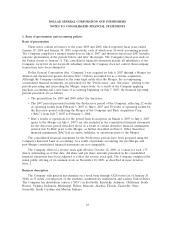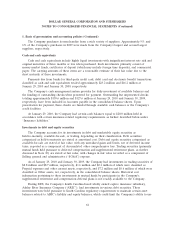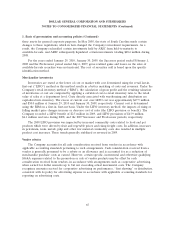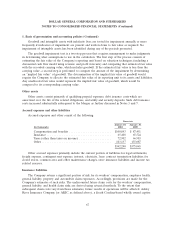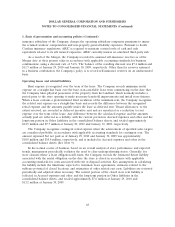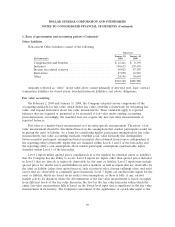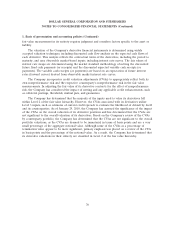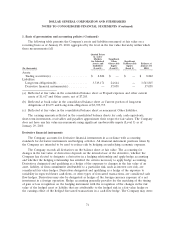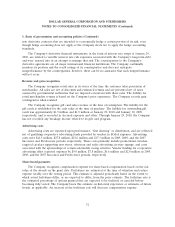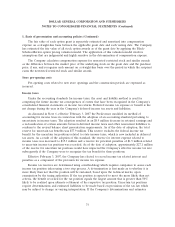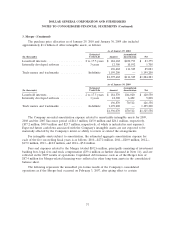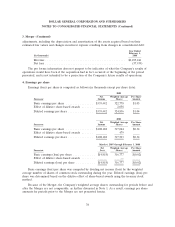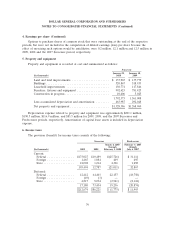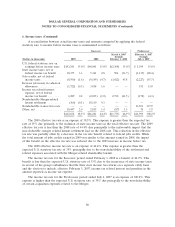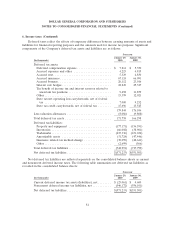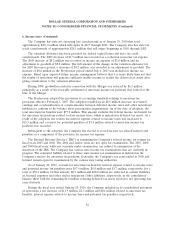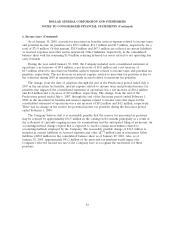Dollar General 2009 Annual Report Download - page 84
Download and view the complete annual report
Please find page 84 of the 2009 Dollar General annual report below. You can navigate through the pages in the report by either clicking on the pages listed below, or by using the keyword search tool below to find specific information within the annual report.DOLLAR GENERAL CORPORATION AND SUBSIDIARIES
NOTES TO CONSOLIDATED FINANCIAL STATEMENTS (Continued)
1. Basis of presentation and accounting policies (Continued)
The fair value of each option grant is separately estimated and amortized into compensation
expense on a straight-line basis between the applicable grant date and each vesting date. The Company
has estimated the fair value of all stock option awards as of the grant date by applying the Black-
Scholes-Merton option pricing valuation model. The application of this valuation model involves
assumptions that are judgmental and highly sensitive in the determination of compensation expense.
The Company calculates compensation expense for nonvested restricted stock and similar awards
as the difference between the market price of the underlying stock on the grant date and the purchase
price, if any, and recognizes such amount on a straight-line basis over the period in which the recipient
earns the nonvested restricted stock and similar awards.
Store pre-opening costs
Pre-opening costs related to new store openings and the construction periods are expensed as
incurred.
Income taxes
Under the accounting standards for income taxes, the asset and liability method is used for
computing the future income tax consequences of events that have been recognized in the Company’s
consolidated financial statements or income tax returns. Deferred income tax expense or benefit is the
net change during the year in the Company’s deferred income tax assets and liabilities.
As discussed in Note 6, effective February 3, 2007 the Predecessor modified its method of
accounting for income taxes in connection with the adoption of an accounting standard pertaining to
uncertainty in income taxes. The adoption resulted in an $8.9 million decrease in retained earnings and
a reclassification of certain amounts between deferred income taxes and other noncurrent liabilities to
conform to the revised balance sheet presentation requirements. As of the date of adoption, the total
reserve for uncertain tax benefits was $77.9 million. This reserve excludes the federal income tax
benefit for the uncertain tax positions related to state income taxes, which is now included in deferred
tax assets. As a result of the adoption of this standard, the reserve for interest expense related to
income taxes was increased to $15.3 million and a reserve for potential penalties of $1.9 million related
to uncertain income tax positions was recorded. As of the date of adoption, approximately $27.1 million
of the reserve for uncertain tax positions would have impacted the Company’s effective income tax rate
subsequently if the Company were to recognize the tax benefit for these positions.
Effective February 3, 2007, the Company has elected to record income tax related interest and
penalties as a component of the provision for income tax expense.
Income tax reserves are determined using a methodology which requires companies to assess each
income tax position taken using a two step process. A determination is first made as to whether it is
more likely than not that the position will be sustained, based upon the technical merits, upon
examination by the taxing authorities. If the tax position is expected to meet the more likely than not
criteria, the benefit recorded for the tax position equals the largest amount that is greater than 50%
likely to be realized upon ultimate settlement of the respective tax position. Uncertain tax positions
require determinations and estimated liabilities to be made based on provisions of the tax law which
may be subject to change or varying interpretation. If the Company’s determinations and estimates
73


